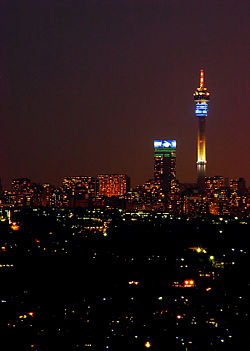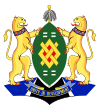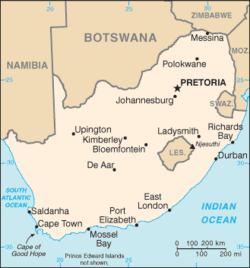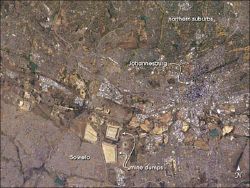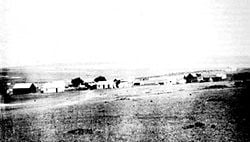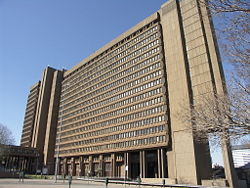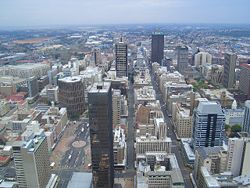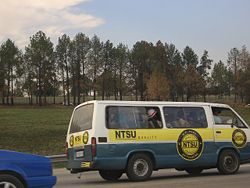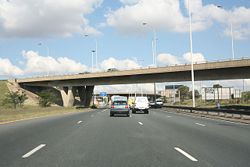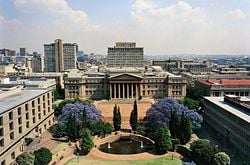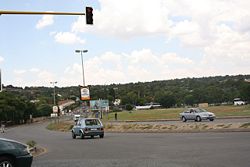Johannesburg
| Johannesburg | |||
| Johannesburg skyline with the Hillbrow Tower in the background | |||
|
|||
| Nickname: Joburg; Jozi; Egoli (City of Gold); Gauteng Maboneng (City of Lights); Joburg my Joburg, Joni; Africa's greatest City | |||
| Motto: Unity in Development | |||
| Location of Johannesburg | |||
| Map of South Africa showing Johannesburg's location | |||
| Coordinates: 26°08′S 27°54′E | |||
|---|---|---|---|
| Country | South Africa | ||
| Province | Gauteng | ||
| Established | 1886 | ||
| Government | |||
| - Mayor | Amos Masondo | ||
| Area [1] | |||
| - Total | 1,644.96 km² (635.1 sq mi) | ||
| Elevation | 1,753 m (5,751 ft) | ||
| Population (2007)[2] | |||
| - Total | 3,888,180 | ||
| - Density | 2,364/km² (6,122.7/sq mi) | ||
| Time zone | SAST (UTC+2) | ||
| Area code(s) | 011 | ||
| Website: www.joburg.org.za | |||
Johannesburg (pronounced /jō-hān'ĭs-bûrg'/), the largest and most populous city in South Africa, is the provincial capital of Gauteng, the wealthiest province in South Africa, having the largest economy of any metropolitan region in Sub-Saharan Africa. The city is one of the 40 largest metropolitan areas in the world,[3] it is one of Africa's only two global cities, the other being Cairo according to the Globalization and World Cities group's 1999 inventory, which classified it as a gamma world city).
Johannesburg is the source of a large-scale gold and diamond trade, due to its location on the mineral-rich Witwatersrand range of hills. Johannesburg is served by O.R. Tambo International Airport, the largest and busiest airport in Africa and a gateway for international air travel to and from the rest of southern Africa.
Gauteng (as a city) is growing rapidly, due to mass urbanisation that is a feature of many developing countries. According to the State of the Cities Report, the urban portion of Gauteng – comprised primarily of the cities of Johannesburg, Ekurhuleni (the East Rand) and Tshwane (greater Pretoria) – will be a polycentric urban region with a projected population of some 14.6 million people by 2015, making it one of the largest cities in the world.
Geography
Johannesburg is located in the eastern plateau area of South Africa known as the Highveld, at an elevation of 5751 feet (1753 meters). The former CBD is located on the south side of the prominent ridge called the Witwatersrand (Afrikaans: White Water's Ridge). The Witwatersrand marks the watershed between the Limpopo and Vaal rivers, and the terrain falls to the north and south. The north and west of the city has undulating hills while the eastern parts are flatter.
The city enjoys a dry, sunny climate, with the exception of occasional late afternoon downpours in the summer months of October to April. Temperatures usually fairly mild thanks to the city's high altitude, with the average maximum daytime temperature in January of 79F (26C), dropping to an average maximum of around 61F (16C) in June. Winter is the sunniest time of the year, with cool days and cold nights. The temperature occasionally drops to below freezing at night, causing frost. Snow is rare. Mean annual precipitation is 28 inches (716mm).
Despite the relatively dry climate, Johannesburg has over 10 million trees. Many trees were planted in the northern areas of the city at the end of the 19th century, to provide wood for mining. The areas were developed by the gold and diamond mining entrepreneur (Randlord), Hermann Eckstein, a German immigrant, who called the forest estates Sachsenwald. The name was changed to Saxonwold, now the name of a suburb, during World War I. Early (white) residents who moved into the areas referred to as the Northern Suburbs, retained many of the original trees and planted new ones. A considerable number of trees were felled, to make way for the Northern Suburbs' residential and commercial redevelopment.
Johannesburg is a divided city, and its suburbs are the product of extensive urban sprawl. The poor mostly live in the southern suburbs, such as Soweto, a mostly black urban area constructed during the apartheid regime, or on the peripheries of the far north, as well as in the inner city.
Traditionally the northern and northwestern suburbs have been the centre for the wealthy, containing the high-end retail shops as well as several upper-class residential areas such as Hyde Park, Sandhurst, Northcliff and Houghton, where Nelson Mandela lives.
History
The region surrounding Johannesburg was originally inhabited by San tribes Rock paintings. By the 1200s, groups of Nthu people started moving southwards from central Africa and encroached on the indigenous San population. White trekboers started entering the area from the Cape Colony after 1860. Gold was discovered in the 1880s and triggered the gold rush.
Gold was initially discovered some 400 km to the east of present-day Johannesburg, in Barberton. Gold prospectors soon discovered that there were even richer gold reefs in the Witwatersrand. Gold was discovered at Langlaagte, Johannesburg in 1886.
Johannesburg was a dusty settlement some 90km from the Transvaal Republic capital which was Pretoria. The town was much the same as any small prospecting settlement, but, as word spread, people flocked to the area from all other regions of the country, as well as from North America, the United Kingdom and Europe. See Charles van Onselen: New Nineveh and New Babylon. As the value of control of the land increased, tensions developed between the Boer government in Pretoria and the British, culminating in the South African War. The Boers lost the war and control of the area was ceded to the British. Controversy surrounds the origin of the name, as there were any number of people with the name "Johannes" who were involved in the early history of the city. The principal clerk attached to the office of the surveyor-general, Johannes Rissik, Christiaan Johannes Joubert, member of the Volksraad and the Republic's chief of mining, Paul Kruger, President of the Zuid Afrikaansche Republiek (Transvaal). Rissik and Joubert were members of a delegation sent to England to attain mining rights for the area. Joubert had a park in the city named after him and Rissik street is today a main street where the (now dilapidated) Post Office and City Hall are located.
Currently the Johannesburg Metropolitan Council is implementing a large scale Inner City Revival project, leading to some business moving back to the inner city.
Government
South Africa is a republic in which the president is both the chief of state and head of government, and is elected by the National Assembly for a five-year term. The bicameral Parliament consists of the National Assembly of 400 members, elected by popular vote under a system of proportional representation to serve five-year terms, and the National Council of Provinces of 90 seats, with 10 members elected by each of the nine provincial legislatures for five-year terms.
While Johannesburg does not form one of South Africa's three capital cities, it does house the Constitutional Court – South Africa's highest court. Cape Town is the legislative capital and seat of the National Parliament, Pretoria is the executive (administrative) and de facto national capital, and Bloemfontein, the judicial capital.
During the apartheid era, Johannesburg was divided into 11 local authorities, seven of which were white and four black or coloured. The white authorities were 90 percent self-sufficient from property tax and other local taxes, and spent ZAR 600 ($US93) per person, while the black authorities were only 10 percent self-sufficient, spending R 100 ($US15) per person.
The first post-apartheid City Council was created in 1995. The council adopted the slogan "One City, One Taxpayer" in order to highlight its goal of addressing unequal tax revenue distribution. To this end, revenue from wealthy, traditionally white areas would help pay for services needed in poorer, black areas.
The City Council was divided into four regions, each with a substantially autonomous local regional authority that was to be overseen by a central metropolitan council. Furthermore, the municipal boundaries were expanded to include wealthy satellite towns like Sandton and Randburg, poorer neighbouring townships such as Soweto and Alexandra, and informal settlements like Orange Farm.
In 1999, Johannesburg appointed a city manager in order to reshape the city's ailing financial situation. The manager, together with the Municipal Council, drew up a blueprint called "Igoli 2002". This was a three-year plan that called upon the government to sell non-core assets, restructure certain utilities, and required that all others become self-sufficient. The plan took the city from near insolvency to an operating surplus of R 153 million ($US23.6-million).
Following the creation of the City of Johannesburg Metropolitan Municipality, Johannesburg was divided into 11 administrative regions (these regions did not correspond to the areas governed by the former local authorities). In 2006, the number of administrative regions was consolidated, from 11 to seven. The regions take on a role as contractors to the central government. The relationship is similar to that of the larger utilities and agencies, such as City Power, and is designed to maximise efficiency.
Each region is operationally responsible for the delivery of health care, housing, sports and recreation, libraries, social development, and other local community-based services. Each region has a People's Centre where any city-related transaction can be dealt with. Residents can lodge complaints, report service problems, and perform council-related business more quickly.
The mayor, chosen by the African National Congress's national executive office, takes ultimate responsibility for the city and leads a 10-person City Council.
The city management team implements decisions taken by the City Council and monitors the performance of the various branches of the city government. The group's head office is the Metro Centre Complex in Braamfontein, which is responsible for overall administration, financial control, supply of services, and collection of revenues. The fire department and ambulances, the metropolitan police and traffic control, museums, art galleries, and heritage sites are all controlled by separate departments within the central administration.
City councillors are either elected in one of Johannesburg's 109 electoral wards, or appointed by proportional representation from a party. The directly appointed councillors have more responsibilities, including setting up committees in their wards to raise local issues and liaising with local ratepayers' and residents' associations. The ward councillors liaise with city management through the regional directors in their areas.
Crime
According to the Johannesburg Victim Survey (1993–1997) the crime most afflicting the city's residents between 1993 and 1997 was burglary, with nearly a quarter of the respondents (24%) reporting this crime to the survey. The second most frequently reported incidents were violent crimes: mugging and robbery (16.5%) and assault (15.5%). The vast majority of assaults were of a serious nature, with 84% involving the use of a weapon.[4]
After the Group Areas Act was scrapped in the early 1990s, Johannesburg was affected by urban blight. Thousands of poor, mostly black, people, who had been forbidden to live in the city proper, moved into the city from surrounding black townships like Soweto. Many immigrants from economically beleaguered and war torn African nations flooded into South Africa, with Johannesburg the most Northerly major city and therein a logical choice. Crime levels rose, and especially the rate of violent crime. [citation needed] Many buildings were abandoned by landlords, especially in high-density areas, such as Hillbrow. Many corporations and institutions, including the stock exchange, moved their headquarters away from the city centre, to suburbs like Sandton. By the late 1990s, Johannesburg was rated as one of the most dangerous cities in the world. [citation needed]
Reviving the city centre is one of the main aims of the municipal government of Johannesburg. Drastic measures have been taken to reduce crime in the city. These measures include closed-circuit television on street corners. Crime levels in Johannesburg have dropped as the economy has stabilised and begun to grow.[5] In an effort to prepare Johannesburg for the 2010 FIFA World Cup, local government has enlisted the help of former New York mayor Rudolph Giuliani to help bring down the crime rate, as the opening and closing matches of the tournament will be played in the city.[6]
Economy
Johannesburg is the economic and financial hub of South Africa, producing 16 percent of South Africa's gross domestic product, and accounts for 40 percent of Gauteng's economic activity. In a 2007 survey conducted by Mastercard, Johannesburg ranked 47 out of 50 top cities in the world as a worldwide centre of commerce (the only city in Africa)
Mining was the foundation of the Witwatersrand's economy, but its importance is gradually declining due to dwindling reserves and service and manufacturing industries have become more significant to the city's economy. While gold mining no longer takes place within the city limits, most mining companies still have their headquarters in Johannesburg.
The city's manufacturing industries extend across a range of areas and there is still a reliance on heavy industries including steel and cement plants. The service and other industries include banking, IT, real estate, transport, broadcast and print media, private health care, transport and a vibrant leisure and consumer retail market. Johannesburg has Africa's largest stock exchange, the JSE Securities Exchange although it has moved out of the central business district. Due to its commercial role, the city is the seat of the provincial government and the site of a number of government branch offices, as well as consular offices and other institutions.
There is also a significant informal economy consisting of cash-only street traders and vendors. The level of this economic activity is difficult to track in official statistics and it supports a sector of the population including immigrants who are not in formal employment. The Witwatersrand urban complex is a major consumer of water in a dry region. Its continued economic and population growth has depended on schemes to divert water from other regions of South Africa and from the highlands of Lesotho, the biggest of which is the Lesotho Highlands Water Project, but additional sources will be needed early in the 21st century.
The city is home to several media groups which own a number of newspaper and magazine titles. The two main print media groups are Independent Newspapers and Naspers (Media24). The electronic media is also headquartered in the greater metropolitan region. Media ownership is relatively complicated with a number of cross shareholdings which have been rationalised in recent years resulting in the movement of some ownership into the hands of black shareholders. This has been accompanied by a growth in black editorship and journalism.
Johannesburg has not traditionally been known as a tourist destination, but the city is a transit point for connecting flights to Cape Town, Durban, and the Kruger National Park. Consequently, most international visitors to South Africa pass through Johannesburg at least once, which has led to the development of more attractions for tourists.
About 19 percent of economically active adults work in wholesale and retail sectors, 18 percent in financial, real estate and business services, 17 percent in community, social and personal services and 12 percent are in manufacturing. Only 0.7 percent work in mining.
Per capita GDP, rank
Johannesburg, much like Los Angeles, is a young and sprawling city geared towards private motorists, and lacks a convenient public transportation system. One of Africa's most famous "beltways" or ring roads/orbitals is the Johannesburg Ring Road. The road is composed of three freeways that converge on the city, forming an 80 kilometers (49.7 mi) loop around it.
Johannesburg is served by a bus fleet consisting of approximately 550 single and double-decker buses, plying 84 different routes in the city. Construction on a new Bus Rapid Transit (BRT) system was under way in 2008. Johannesburg has two kinds of taxis, metered taxis, and minibus taxis, which are often of a poor standard in not only road-worthiness, but also in terms of driver quality.
Johannesburg's metro railway system connects central Johannesburg to Soweto, Pretoria, and most of the satellite towns along the Witwatersrand. The railways transport huge numbers of workers every day. However, the railway infrastructure was built in Johannesburg's infancy and covers only the older areas in the city's south. The Gautrain Rapid Rail, which was under construction in 2008, will consist of a number of underground stations, as well as above ground stations, and will run from Johannesburg's Park Station, through Rosebank, Sandton, Midrand and into Pretoria.
Johannesburg is served by OR Tambo International Airport (formerly Johannesburg International Airport) for both domestic and international flights. Other airports include Rand Airport, Grand Central Airport, and Lanseria.
Demographics
The population of Johannesburg was 3,888,180 in 2007, while the population of the Greater Johannesburg Metropolitan Area was almost eight million. Johannesburg's land area of 635 square miles (1645 square kilometers) is large when compared to other cities, resulting in a population density of 6123 per square mile (2364 per square kilometer). Johannesburg and Pretoria are beginning to act as one functional entity, connecting the province of Gauteng together and forming one Megacity of roughly 10 million people.
People who live in formal households number 1,006,930, of which 86 percent have a flush or chemical toilet, 91 percent have refuse removed by the municipality at least once a week, 81 percent have access to running water, and 80 percent use electricity as the main source of energy. About 22 percent of Johannesburg residents stay in informal dwellings, and 66 percent of households are headed by one person.
Black Africans account for 73 percent of the population, followed by whites at 16 percent, coloureds at 6 percent and Asians at 4 percent. About 42 percent of the population is under the age of 24, while 6 percent of the population is over 60 years of age. A substantial 37 percent of city residents are unemployed, of which 91 percent. Women comprise 43 percent of the working population.
The poor are mostly black, earn less than Rand 25,000 per annum. The wealthy are mostly white. Around 20 percent of the city lives in abject poverty in informal settlements that lack proper roads, electricity, or any other kind of direct municipal service.
Regarding languages, 34 percent of Johannesburg residents speak Nguni languages at home, 26 percent speak Sotho languages, 19 percent speak English, and 8 percent speak Afrikaans.
Regarding religion, 53 percent belong to mainstream Christian churches, 24 percent are not affiliated with any organized religion, 14 percent are members of African Independent Churches, 3 percent are Muslim, 1 percent are Jewish and 1 percent are Hindu.
Johannesburg has a well-developed higher education system of both private and public universities. Johannesburg is served by the public universities the University of the Witwatersrand, famous as a centre of resistance to apartheid, earning it the nickname "Moscow on the Hill", and the University of Johannesburg.
About 14 percent have higher education (University or Technical school), 29 percent of adults have graduated from high school, 15 percent have primary education, and 7 percent are illiterate.
Music
Kwaito is the musical genre from Johannesburg that is considered to be the post-struggle (post-apartheid) music of choice by South African youth. Some consider Kwaito to be apolitical dance music because the same lyrics are typically repeated throughout the entire song and are placed over the rhythms and beats of House music. However, others argue that Kwaito has an important political message to spread, despite the fact people are able to dance to this music. For example, the artist called Arthur stands up against the established system set during apartheid saying, "Nee baas, don't call me kaffir" in his 1995 song titled "Kaffir". The timing of such a politically charged statement was necessary in the South African society because apartheid had recently been abolished. It is important to note the significance of the words in this phrase. The word "baas" is equivalent to the English word "boss" and was the mandatory title all black employees had to use to address their white employers during apartheid. "Kaffir" is one of the most derogatory and degrading racial names someone can call a black person in South Africa. Because Arthur was commenting on the social relation between black workers and their white bosses and the racial inequality that existed between them, his EP was "an incredibly powerful and provocative statement" that "went straight to the hearts of thousands of South Africans."[7] Kwaito artist Mandoza is another reason why many people argue Kwaito music does have significant political standing in South Africa. One example of Mandoza's political message can be heard with his song "Uzoyithola Kkanjani", which means "how are you going to get it if you don't go for it".
Kwaito has touched more than the music scene in this country. In recent years, it has become deeply embedded in young South African culture because it represents "the streets", street life, and the people who live there. As Grant Clark notes after his trip to Johannesburg, "Kwaito has evolved its own street style. It's not just music, it's the way you walk, talk, dance, and of course, dress." [8] On the other hand, Kwaito does receive its share of criticism from the older generations for embracing what is considered to be Western ideals and beliefs, like materialism and living life in excess. Despite this, there are some older South African musicians who support this musical style. Hugh Masekela is a known fan of Kwaito. When talking about Kwaito, the artist said, "there has been criticism of some of the content of Kwaito music but older people always seem to be jealous of young people who are coming up with new things." [8] Whether Kwaito is criticized for its lack of a political stance or looked down upon by South African elders for straying from their own traditions and values, it definitely has had a impact on the music and culture of post-apartheid society in South Africa.
Of Interest
Recent additions have centred around history museums, such as the Apartheid Museum and the Hector Pieterson Museum. Gold Reef City, a large amusement park to the south of the Central Business District, is also a large draw for tourists in the city. The Johannesburg Zoo is also one of the largest in South Africa.
The city also has several art museums, such as the Johannesburg Art Gallery, which featured South African and European landscape and figurative paintings. The Museum Africa covers the history of the city of Johannesburg, as well as housing a large collection of rock art. The Market Theatre complex attained notoriety in the 1970s and 1980s by staging anti-apartheid plays, and has now become a centre for modern South African playwriting.
There is also a large industry around visiting former townships, such as Soweto and Alexandra. Most visitors to Soweto go to see the Mandela Museum, which is located in the former home of Nelson Mandela.
The Cradle of Humankind UNESCO World Heritage Site is 25 kilometers (16 mi) to the northwest of the city. The Sterkfontein fossil site is famous for being the world's richest hominid site and produced the first adult Australopithecus africanus and the first near-complete skeleton of an early Australopithecine.
Sports teams and stadiums
Template:Johannesburg sports Johannesburg's most popular sports by participation are association football, cricket, rugby union, and running. The Lions, formerly the Cats, represent Johannesburg, North West and Mpumalanga in the Southern Hemisphere's Super 14 Rugby Competition, which includes teams from South Africa, Australia, and New Zealand.
Cricket is one of the more popular sports. In cricket, the Highveld Lions represent Johannesburg, the rest of Gauteng as well as the North West Province at the Wanderers Stadium which was the venue for the 2003 Cricket World Cup Final in which Australia successfully defended their title. Wanderers Stadium hosted what many cricket fans consider the greatest ever ODI match in which South Africa successfully chased down 434 runs. They take part in the Supersport and MTN Domestic Championship.
Johannesburg also hosted matches from and the final of the ICC World T20. in which India beat Pakistan in the final.
Early each Sunday morning, tens of thousands of runners gather to take part in informal runs organised by several athletic clubs. People from Johannesburg are football mad[attribution needed] and clubs from Johannesburg either play in the Premier Soccer League (PSL) or the First Division. In the PSL, the top Johannesburg teams are all fierce rivals and include Kaizer Chiefs (also known as the Amakhosi), Orlando Pirates (also known as the Buccaneers) and Moroka Swallows, based at the city's Johannesburg, Rand, and FNB stadiums respectively. Witwatersrand University, nicknamed the Clever Boys, who have a player membership of over 1,500, one of the world's largest are also part of the premier league. First Division teams include Katlehong City and Alexander United, who play at Alexander and Reiger Park stadiums respectively
Notes
- ↑ Municipal Demarcation Board, South Africa Retrieved on 2008-03-23.
- ↑ Statistics South Africa, Community Survey, 2007, Basic Results Municipalities (pdf-file) Retrieved on 2008-03-23.
- ↑ Principal Agglomerations of the World
- ↑ Victims of Crime in Johannesburg by Antoinette Louw, Mark Shaw, Lala Camerer, Rory Robertshaw, Published in Monograph No 18, Crime in Johannesburg, February 1998.
- ↑ Drop in serious crime in Jo'burg, Mail & Guardian Online, 2006-07-07.
- ↑ Press Release August 062006, City of Johannesburg is calling for Internal Branding Advice from Global Gurus.
- ↑ Steingo, Gavin. "South African music after Apartheid: kwaito, the "party politic", and the appropriation of gold as a sign of success." In Popular Music and Society. July 2005. http://findarticles.com/p/articles/mi_m2822/is_3_28/ai_n15648564/pg_4
- ↑ 8.0 8.1 Clark, Grant. "Kwaito: The Voice of Youth." From BBC World Service "Rhythms of the Continent: South Africa". http://www.bbc.co.uk/worldservice/africa/features/rhythms/southafrica.shtml
ReferencesISBN links support NWE through referral fees
- Cartwright, Alan Patrick. 1965. The corner house: the early history of Johannesburg. Cape Town: Purnell. OCLC 3742920
- Lange, Lis. 2003. White, poor, and angry: white working class families in Johannesburg. Aldershot, Hampshire, England: Ashgate. ISBN 9780754609155
- Meiring, Hannes, G.-M. Van der Waal, Wilhelm Grütter, and Anna Jonker. 1986. Early Johannesburg, its buildings and its people. Cape Town: Human & Rousseau. ISBN 9780798114561
- Nuttall, Sarah, and J.-A. Mbembé. 2004. Johannesburg: the elusive metropolis. Public culture, v. 16, no. 3. Durham, N.C.: Duke University Press. ISBN 9780822366102
- Rosenthal, Eric. 1970. Gold! Gold! Gold! The Johannesburg gold rush. [New York]: Macmillan. ISBN 0-949937-64-9
See also
- Large Cities Climate Leadership Group
External links
Government
News
Other
- Business in Johannesburg
- Economist.com City Guide
- Gauteng Tourism Authority
- Happenings and Tourist Info
- Johannesburg Guide
- Johannesburg on Birmingham's Partner City page
- Johannesburg on Google Maps
- Johannesburg Tourism official website
- Travel guide to Johannesburg from Wikitravel
- Official Web Portal of South Africa
- Pictures of Johannesburg post-apartheid
- VisitSouthAfrica.net
Credits
New World Encyclopedia writers and editors rewrote and completed the Wikipedia article in accordance with New World Encyclopedia standards. This article abides by terms of the Creative Commons CC-by-sa 3.0 License (CC-by-sa), which may be used and disseminated with proper attribution. Credit is due under the terms of this license that can reference both the New World Encyclopedia contributors and the selfless volunteer contributors of the Wikimedia Foundation. To cite this article click here for a list of acceptable citing formats.The history of earlier contributions by wikipedians is accessible to researchers here:
The history of this article since it was imported to New World Encyclopedia:
Note: Some restrictions may apply to use of individual images which are separately licensed.
